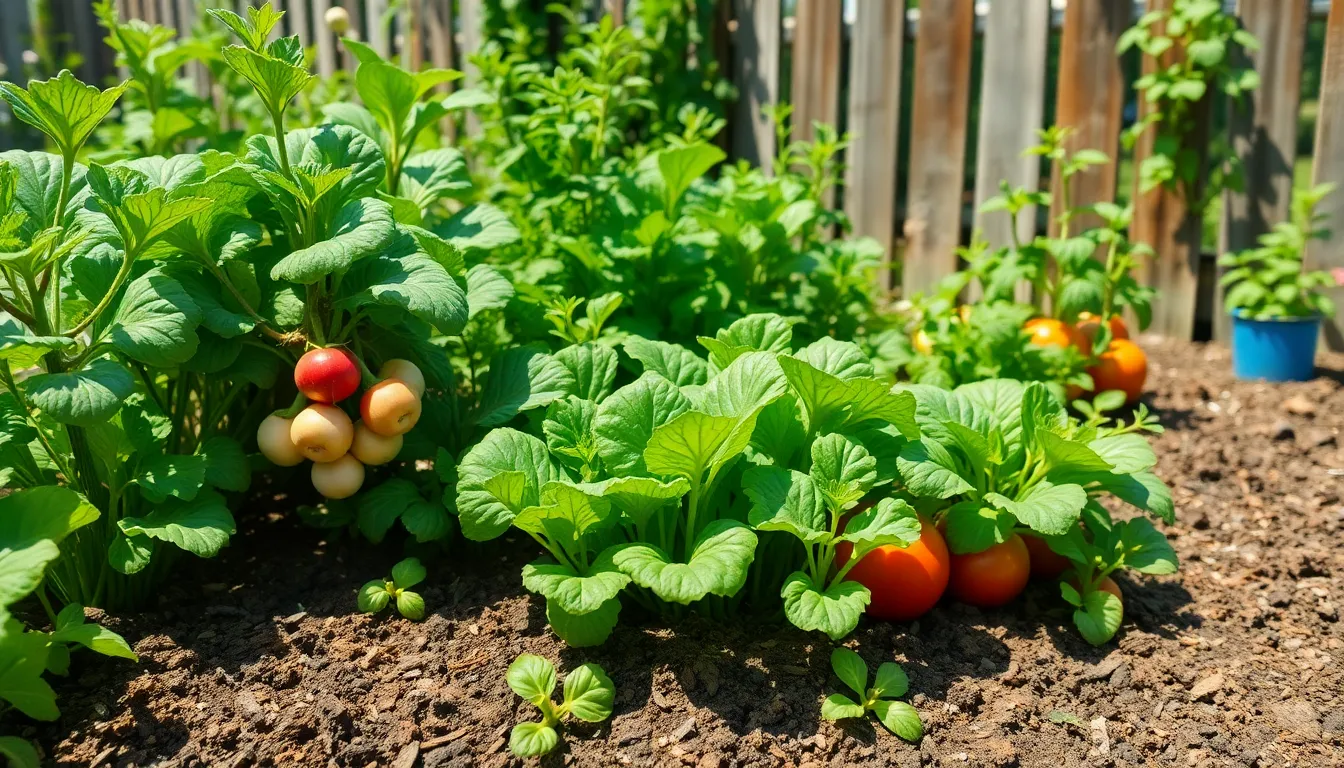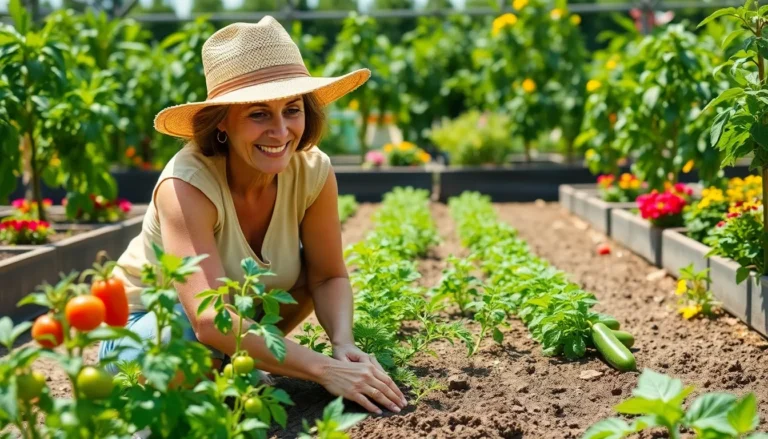Imagine stepping into your backyard and being greeted by a vibrant patch of fresh veggies, all begging to be picked. A small vegetable garden isn’t just a space; it’s a culinary adventure waiting to happen. With a little soil and some sunshine, anyone can transform a tiny corner into a green oasis that’s both satisfying and delicious.
Small Vegetable Garden
Small vegetable gardens provide numerous advantages that enhance health and well-being. They promote access to fresh produce and offer various nutritional benefits.
Nutritional Advantages
Fresh vegetables boast higher nutrient levels than their store-bought counterparts. They contain essential vitamins and minerals that support overall health. Improved flavor occurs when vegetables are harvested at peak ripeness, leading to a more satisfying culinary experience. Growing a diverse range of vegetables, like tomatoes, peppers, and leafy greens, ensures a well-rounded nutrient intake. A small garden allows individuals to choose organic practices, reducing exposure to pesticides and chemicals.
Environmental Impact
Small vegetable gardens contribute positively to the environment. They promote biodiversity by attracting beneficial insects and pollinators. Reducing food miles occurs when individuals harvest produce from their own gardens, cutting back on greenhouse gas emissions linked to transportation. Soil health improves with sustainable practices, such as composting and crop rotation. Additionally, small gardens help manage stormwater runoff and provide habitat for local wildlife.
Planning Your Small Vegetable Garden

Planning a small vegetable garden requires careful consideration of location and the selection of vegetables. Both factors significantly impact the garden’s success.
Selecting The Right Location
Choosing an optimal location for the garden enhances growth. The spot should receive at least six hours of direct sunlight daily, ensuring robust plant health. Avoid areas with excessive shade from trees or structures. Well-draining soil plays a crucial role; it prevents waterlogging, allowing roots to thrive. Proximity to a water source simplifies maintenance, making it easier to keep plants hydrated. Assessing wind exposure is also essential, as strong winds can damage delicate seedlings. Overall, this selection process lays a strong foundation for a thriving vegetable garden.
Choosing Suitable Vegetables
Selecting the right vegetables maximizes productivity and enjoyment. Start with varieties that grow well in the local climate, as they adapt better and yield higher. Fast-growing options, like radishes and lettuce, provide quick satisfaction. Additionally, consider personal dietary preferences; growing favorites encourages regular harvesting. Grouping vegetables with similar needs simplifies care, streamlining watering and fertilization routines. Local growing seasons influence planting times, allowing for multiple harvests in a single year. Ultimately, this mindful approach fosters a diverse and fruitful garden.
Gardening Techniques For Success
Successful small vegetable gardening relies on effective techniques. Focus on soil quality and consistent watering.
Soil Preparation
Soil preparation lays the foundation for healthy plants. Test the soil pH; vegetables prefer a range of 6.0 to 7.0. Amend with organic matter like compost to enrich nutrient content. Consider incorporating well-rotted manure or peat moss to improve texture and drainage. Cultivating the soil to a depth of 12 inches promotes root growth. Tilling enhances aeration while mixing in nutrients, creating an optimal environment for root systems. Finally, mulch helps retain moisture and suppress weeds.
Watering and Maintenance
Watering remains crucial for sustaining plant health. Establish a schedule; most vegetables require about one inch of water per week. Use drip irrigation or soaker hoses to deliver moisture efficiently and prevent evaporation. Inspect plants regularly for signs of pests or diseases; early detection promotes swift intervention. Pruning helps maintain air circulation and supports plant health. Fertilizing every four to six weeks with a balanced fertilizer provides necessary nutrients for growth. Finally, rotate crops each season to prevent soil depletion and reduce disease risk.
Pest Management In A Small Vegetable Garden
Pest management is crucial for maintaining a thriving small vegetable garden. Effective control strategies minimize damage and promote healthy growth.
Common Pests and Solutions
A few common pests often target vegetable gardens. Aphids, for instance, feed on plant sap and create sticky residues. They affect the vitality of many vegetable varieties. In addition, caterpillars can cause significant leaf damage by consuming foliage. Solutions include regularly inspecting plants for signs of these pests. Handpicking is effective for caterpillars while insecticidal soap can eliminate aphids. Maintaining biodiversity with companion plants also deters many pests naturally. Observing plants closely leads to early detection, enhancing overall garden health.
Organic Pest Control Options
Organic pest control methods support sustainability while protecting crops. Neem oil serves as an effective pesticide, disrupting insect life cycles. Garlic spray acts as a natural repellent against various pests. Introducing beneficial insects, like ladybugs, can naturally reduce aphid populations. Also, planting marigolds can repel nematodes and deter pests. Crop rotation prevents pest establishment by changing plant locations yearly. Using row covers offers physical barriers against harmful insects, ensuring crops remain safe. Prioritizing these organic methods contributes to a healthier garden ecosystem.
Seasonal Considerations
Seasonal factors play a vital role in the success of a small vegetable garden. Understanding the appropriate planting and maintenance techniques for each season greatly enhances productivity.
Spring Planting Tips
Start planting as soon as the soil temperature reaches 50°F for early crops like peas and radishes. Consider planting warm-season vegetables once the danger of frost has passed. Space plants according to their mature size to allow for air circulation. Focus on choosing varieties that thrive locally, which encourages healthy growth. A well-timed planting schedule maximizes harvests throughout the growing season. Regularly check moisture levels to avoid drying out young plants. Fertilize with a balanced mix, adding organic matter to promote soil health.
Winter Maintenance Strategies
Prepare for winter by cleaning up garden debris to avoid pest infestations. Mulch around plants insulates the roots and prevents frost damage. Consider planting cover crops like clover or winter rye to enrich the soil during the cold months. Protect sensitive plants with row covers or cold frames. Regular checks throughout winter ensure that any exposed plants are adequately sheltered. Watering occasional sunny days maintains hydration for wintering plants. Plan for next spring by reviewing successes and challenges from the past season.
Conclusion
Creating a small vegetable garden offers countless rewards that extend beyond just fresh produce. It fosters a deeper connection with nature while promoting healthier eating habits. By investing time and effort into a small garden, individuals can enjoy the satisfaction of growing their own food and contributing positively to the environment.
With proper planning and sustainable practices, anyone can cultivate a thriving garden that provides nourishment and joy. Embracing this green endeavor not only enhances personal well-being but also supports local ecosystems. Whether one is a seasoned gardener or a beginner, the journey of nurturing a small vegetable garden is truly fulfilling.




